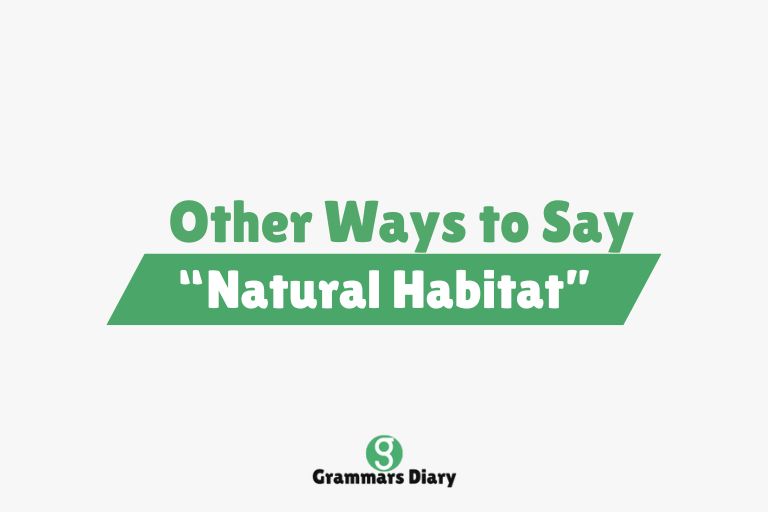20 Other Ways to Say “Natural Habitat”

The phrase “natural habitat” refers to the environment in which a species typically lives and thrives without human interference, such as a forest for deer or a coral reef for clownfish. It signifies the specific ecosystem where an organism finds all the conditions it needs—like food, shelter, climate, and companionship—for survival and reproduction.
However, English offers many alternative ways to express this concept depending on the tone, setting, and precision required. Whether you’re writing an academic paper, explaining wildlife conservation to kids, or crafting poetic prose, choosing the right alternative to “natural habitat” can enrich your language and clarify your message.
This post explores 20 thoughtful, nuanced synonyms or near-synonyms of “natural habitat,” each explained with examples, context, and ideal usage scenarios to help you speak and write with greater accuracy and flair.
Other Ways to Say “Natural Habitat”
1. Native Environment
Example: “The giant panda’s native environment is the bamboo forests of China.”
Meaning: The original or ancestral area where a species naturally exists and has adapted to survive over time.
Usage: Common in both formal and informal settings when referring to a species’ original ecological zone.
2. Natural Surroundings
Example: “Efforts are underway to protect the elephant’s natural surroundings from deforestation.”
Meaning: The broader ecosystem or landscape in which a species lives, with emphasis on its undisturbed nature.
Usage: Often used in casual speech or environmental advocacy to convey a sense of ecological purity.
3. Ecosystem
Example: “Each animal plays a role in its ecosystem, helping maintain balance and biodiversity.”
Meaning: A dynamic community of living organisms interacting with one another and their non-living environment.
Usage: Ideal in academic, ecological, or scientific contexts where complex interdependencies are being discussed.
4. Natural Range
Example: “The snow leopard’s natural range includes the rugged mountains of Central Asia.”
Meaning: The geographic area a species naturally inhabits without human introduction or intervention.
Usage: Frequently used in conservation literature, research studies, and wildlife biology.
5. Ecological Niche
Example: “Each species fills a unique ecological niche, adapting to specific environmental roles.”
Meaning: A more technical term that describes both the habitat and functional role a species has in its environment.
Usage: Best suited for scientific discourse or biology-focused discussions.
6. Wild Habitat
Example: “Conservationists work to preserve the wild habitat of endangered species.”
Meaning: A naturally occurring living space that has not been domesticated or artificially altered by humans.
Usage: Appropriate for wildlife documentaries, environmental speeches, or nature-focused writing.
7. Natural Ecosystem
Example: “Restoring the wetlands will help revive the natural ecosystem that supports local bird species.”
Meaning: A term highlighting the original, unmodified system of organisms and their environment.
Usage: Often employed in environmental science, land restoration efforts, and conservation education.
8. Living Environment
Example: “Pollution is drastically changing the fish’s living environment in coastal areas.”
Meaning: Refers to the immediate natural space where an organism exists and interacts with its surroundings.
Usage: Versatile across formal reports and everyday environmental discussions.
9. Biome
Example: “The Amazon rainforest is the world’s largest tropical rainforest biome.”
Meaning: A large-scale category of natural habitat characterized by climate, flora, and fauna.
Usage: Useful in geography, ecology, and academic settings to classify habitats by regional climate types.
10. Original Habitat
Example: “The wolves were reintroduced into their original habitat to restore ecological balance.”
Meaning: The first or earliest-known area a species lived in before changes like migration or captivity occurred.
Usage: Works well in scientific or restoration contexts where historical context is important.
11. Native Habitat
Example: “Frogs are rapidly disappearing from their native habitat due to water pollution and deforestation.”
Meaning: The natural location where a species originally evolved and continues to live without external influence.
Usage: Frequently found in conservation efforts, biology textbooks, and nature preservation campaigns.
12. Natural Environment
Example: “Introducing non-native species can drastically alter the natural environment of an ecosystem.”
Meaning: The unmodified physical and biological conditions that surround a species in the wild.
Usage: A widely accepted phrase across formal and informal writing about ecosystems or animal welfare.
13. Undisturbed Habitat
Example: “The wildlife sanctuary was created to provide an undisturbed habitat for breeding birds.”
Meaning: A habitat that has remained untouched or minimally affected by human activity.
Usage: Effective in environmental research and ecotourism narratives focused on pristine wilderness areas.
14. Wild Environment
Example: “Animals raised in captivity often struggle to adjust when released into the wild environment.”
Meaning: A habitat outside of human control, emphasizing a setting where natural laws govern survival.
Usage: Common in wildlife rehabilitation and discussions about the differences between captivity and nature.
15. Home Territory
Example: “Lions often patrol their home territory to ward off rivals and protect their pride.”
Meaning: A region that an animal or species claims as its own, often tied to its natural lifestyle and social behaviors.
Usage: Well-suited for storytelling, wildlife observation reports, and behavioral studies.
16. Natural Domain
Example: “The grizzly bear roams freely in its natural domain, far from urban settlements.”
Meaning: A poetic or formal way to describe the native living space of an organism.
Usage: Ideal for creative writing or expressive environmental journalism.
17. Original Ecosystem
Example: “Reintroducing the species into its original ecosystem has been a key conservation goal.”
Meaning: The actual system of organisms and environment where the species once thrived.
Usage: Used in research and restoration projects focusing on ecological recovery.
18. Indigenous Range
Example: “The koala is now confined to a fraction of its indigenous range.”
Meaning: The geographical span that a species has historically occupied without external relocation.
Usage: Common in ecological studies and wildlife mapping to highlight habitat loss or displacement.
19. Prime Habitat
Example: “Wetlands provide prime habitat for a wide variety of amphibians and birds.”
Meaning: The most ideal or optimal environment for a species to thrive and reproduce.
Usage: Appears in conservation literature and policy planning when prioritizing preservation areas.
20. Wildlife Habitat
Example: “Protecting wildlife habitat is crucial to maintaining biodiversity.”
Meaning: A general term referring to the area where wild animals live and interact naturally.
Usage: Very common in environmental education, public awareness campaigns, and legal frameworks.
When to Use Different “Natural Habitat” Alternatives
In Environmental or Scientific Writing
In professional and research-based discussions related to biodiversity, ecology, or conservation, terms like “ecosystem,” “biome,” or “ecological niche” offer the precision and depth needed to clearly define where a species lives and its role within that system.
In Creative or Descriptive Writing
When crafting nature-focused prose, poetry, or environmental journalism, expressive phrases such as “natural domain” or “wild environment” add a lyrical, vivid tone that captures the spirit of wilderness or the drama of survival.
In Everyday Conversations
In informal contexts, speaking about animals or nature with friends or children, it’s often easier to use clear and accessible alternatives like “home territory,” “natural surroundings,” or “wildlife habitat” that still convey the idea effectively.
Conclusion
“Natural habitat” is a foundational term in environmental conversation, but using richer, more tailored language can not only clarify your meaning but also make your speech or writing more engaging, accurate, and contextually appropriate. Whether you’re aiming for technical precision or creative resonance, the 20 alternatives we’ve explored here provide you with flexible options to match your message with your audience.
For even more detailed linguistic alternatives, exploring entries on trusted platforms like Merriam-Webster or specialized ecology glossaries can offer additional insight.
FAQs
What does “natural habitat” mean?
It refers to the environment in which a species normally lives and grows, including all the natural conditions that support its survival.
Is “natural habitat” a scientific term?
Yes, it’s commonly used in ecology and biology, but it’s also widely understood in general usage and environmental discussions.
Are “ecosystem” and “habitat” the same?
Not exactly. A habitat is the specific environment an organism lives in, while an ecosystem includes all the interactions among organisms and between organisms and their environment in a given area.
Can I use “biome” instead of “natural habitat”?
You can, but “biome” refers to much larger ecological zones, so use it when referring to large-scale classifications like tundras, deserts, or rainforests.






